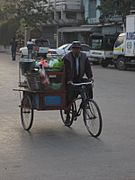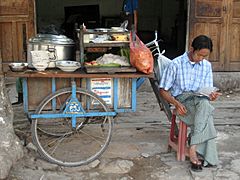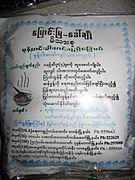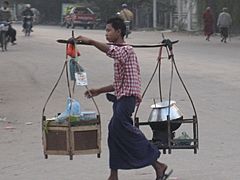Mohinga facts for kids
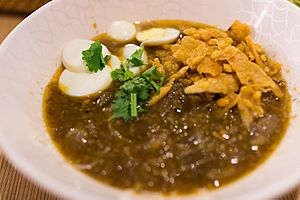
Mohinga with fritters
|
|
| Alternative names | Mont hin gar |
|---|---|
| Course | Breakfast |
| Place of origin | Myanmar |
| Associated national cuisine | Burmese cuisine |
| Main ingredients | Rice vermicelli, catfish |
| Ingredients generally used | Fish sauce, fish paste, ginger, banana stem, lemongrass, onions, garlic, chickpea flour |
| Variations | Many; see §Regional varieties below |
Mohinga (Burmese: မုန့်ဟင်းခါး; MLCTS: mun.hang: hka:, IPA: [mo̰ʊɰ̃hɪ́ɰ̃ɡá]; also spelt mont hin gar) is a delicious rice noodle and fish soup. It comes from Myanmar, a country in Southeast Asia. Many people consider Mohinga to be the national dish of Myanmar.
You can find Mohinga almost everywhere in Myanmar. Street sellers and small shops in big cities often sell it. Traditionally, people eat Mohinga for breakfast. But today, you can enjoy this tasty soup at any time of the day!
Contents
What is Mohinga?
Mohinga is a rich and flavorful soup. It has a thick broth made from several ingredients. The main ingredients include gram flour (a type of chickpea flour) or crushed toasted rice. It also contains garlic, shallots or onions, lemongrass, ginger, fish paste, and fish sauce. The most important part is the catfish or other types of fish like Mrigal carp.
How is it served?
All these ingredients are cooked together in a broth. This broth is kept hot and ready to serve. Mohinga is served with rice vermicelli noodles.
You can add many toppings to your Mohinga. These include more fish sauce and a squeeze of lime. People also add crispy fried onions, fresh coriander, and spring onions. For a bit of spice, crushed dried chillies are popular.
Popular toppings
There are also optional toppings that make Mohinga even better. You can add deep-fried Burmese fritters. These might be made from split chickpeas or urad dal. Some people like gourd fritters or sliced pieces of Chinese donuts. A boiled egg and fried fish cake (called ngapi) are also common additions.
People usually eat Mohinga with Chinese soup spoons. In Myanmar, these spoons are called mohinga zun, which means "mohinga spoons."
Where to find Mohinga
Mohinga is a very common breakfast in Myanmar. Many towns and cities offer it as an "all-day breakfast." You can find it made from scratch in restaurants. Sometimes, people use a ready-made powder to quickly prepare the broth.
In the past, Mohinga was mostly sold early in the morning. It was also available at outdoor events like pwès (stage performances) or theatres at night. Today, street hawkers still sell Mohinga. Some carry a big pot of soup on a stove. They balance it on one side of a carrying pole. On the other side, they carry noodles, bowls, and spoons.
Since the 1960s, trishaw peddlers (people who ride a three-wheeled bicycle taxi) also started selling Mohinga. Some even set up small stalls on the pavement. This made Mohinga available all day long.
-
A mohinga trishaw peddler in Mandalay will stop for customers.
History of Mohinga
It's hard to know exactly when Mohinga first appeared. There are no old records that clearly state its origins. However, tools used to process rice for fermentation have been found. These tools date back to the time of the Pyu city-states. This shows that making rice vermicelli, a key part of Mohinga, has a very long history in Myanmar.
The earliest mention of Mohinga is from the Konbaung dynasty. A poet named U Ponnya wrote about it in a poem. A historian named Khin Maung Nyunt believes that Mohinga was likely a common person's dish long ago. This is because no official recipes for Mohinga have been found in royal records or old cookbooks.
During the reign of King Bagyidaw, another poet, U Min, wrote about Mohinga. He used the phrase "mont di" (မုန့်တီ). Today, mont di usually refers to a different type of rice noodle dish. But a few people still use "mont ti" to mean Mohinga. In different parts of Myanmar, Mohinga is sometimes simply called "mont" (မုန့်) or "mont hin" (မုန့်ဟင်း).
Regional varieties
Mohinga has many different versions across Myanmar. These differences depend on what ingredients are available. They also depend on local cooking styles.
For example, Mohinga from Rakhine State has more ngapi (fish paste). It also has less soup. The most common type of Mohinga comes from Lower Myanmar. This area has a lot of fresh fish. These types of Mohinga are often called tawchet mohinga, meaning "rural style Mohinga." Many famous Mohinga shops in Yangon serve this style. Examples include Myaungmya Daw Cho and Bogalay Daw Nyo.
Varieties from Irrawaddy Delta
The Irrawaddy Delta region has several Mohinga versions:
- Bogale Mohinga: Cooked with fish broth and lots of black pepper.
- Myaungmya Mohinga: Made with three kinds of fish: striped snakehead, walking catfish, and Hamilton's carp.
- Pyapon Mohinga, Pathein Mohinga, and Yangon Mohinga: Yangon's version uses catfish, chickpeas, and peanuts in its broth.
Varieties from Bago Region
The Bago Region also has its own unique Mohinga styles:
- Hinthada Mohinga: Uses hilsa fish instead of catfish.
- Madauk Mohinga: Cooked with pickled shrimp and served with fresh tomatoes.
- Nyaunglebin and Pyuntaza Mohinga: Made with pickled fish and served with pickled jujube fruit.
- Taungoo Mohinga: Has a thinner broth, more like a dry noodle salad. It's served with fresh tomatoes, chopped green beans, and pickled white jujubes on the side.
Varieties from Southern and Eastern Myanmar
Southern and Eastern Myanmar offer more variations:
- Dawei Mohinga: Similar to regular Mohinga, but uses black pepper instead of paprika.
- Kayin Mohinga: Served with either a sweet or spicy broth. It comes with fresh tomatoes, bean sprouts, green beans, and mint instead of coriander.
- Mawlamyine Mohinga: Has a thinner broth. It includes boiled peas, green beans, mint, fish cakes, and jaggery (palm sugar).
- Mon Mohinga: Similar to regular Mohinga, but without banana stems and rice flour.
- Thaton Mohinga: Served with Hamilton's carp, mint, green beans, bean sprouts, tomatoes, and fermented yellow rice cake patties.
Varieties from Upper Myanmar
In Upper Myanmar, you can find these versions:
- Anya Mohinga: Made with chicken, fish, and chickpea flour instead of toasted rice flour. This is common in towns like Monywa, Wetlet, Shwebo, Kyaukpadaung, and Myingyan.
- In Mohinga: Cooked with catfish and green onions in the broth.
See also
 In Spanish: Mohinga para niños
In Spanish: Mohinga para niños


